人教版必修一unit4 earthquakes语法教案
- 格式:doc
- 大小:57.50 KB
- 文档页数:13
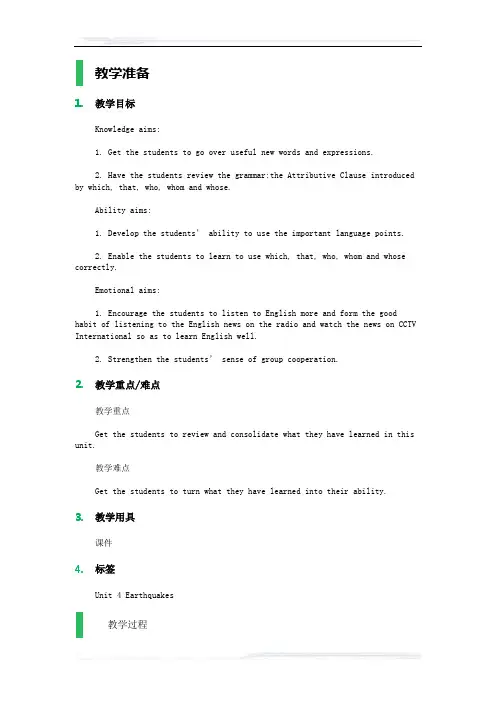
教学准备1. 教学目标Knowledge aims:1. Get the students to go over useful new words and expressions.2. Have the students review the grammar:the Attributive Clause introduced by which, that, who, whom and whose.Ability aims:1. Develop the students’ ability to use the important language points.2. Enable the students to learn to use which, that, who, whom and whose correctly.Emotional aims:1. Encourage the students to listen to English more and form the good habit of listening to the English news on the radio and watch the news on CCTV International so as to learn English well.2. Strengthen the students’ sense of group cooperation.2. 教学重点/难点教学重点Get the students to review and consolidate what they have learned in this unit.教学难点Get the students to turn what they have learned into their ability.3. 教学用具课件4. 标签Unit 4 Earthquakes教学过程Step 1 Revision1. Check the homeworkexercises.2. Dictate some usefulnew words and expressions in this unit.→Step 2 Lead-inTell the students:Up tonow, we have finished Unit 4. Have you learned and grasped all in this unit?Turn to Page 32. You can check yourself by filling in the blanks in the partSumming Up.→Step 3 Summing UpFive minutes for thestudents to sum up by themselves. Then check and explain something wherenecessary.Suggested answers:Write down what you havelearned about earthquakes.We have learned basicknowledge about earthquakes, how to protect oneself and help others in anearthquake.From this unit you havealso learneduseful verbs:shake,rise, crack, burst, ruin, injure, destroy, shock, rescue, organize, bury,judge, honor, prepareuseful nouns:shake,well, rise, crack, pond, pipe, burst, canal, steam, dirt, ruin, survivor,brick, dam, steel, shock, quake, electricity, disaster, army, coal, mine,shelter, percent, speech, judge, honor, Europeother expressions:rightaway, at an end, dig out, a(great)number of, give out, thousands ofnew grammar item:theAttributive Clause introduced by which, that, who, whom and whose→Step 4 Word andexpression exercisesShow the exercises onthe screen or give out exercise papers.1. Complete thefollowing sentences with the proper forms of the words and expressions givenbelow.shake honor percent burst prepare rescue injure destroy shock judge ruininstead of a(great)number of at an end dig out1)He was______________for his courage in battle.2)Will you helpme______________ for the get-together of the old classmates?3)The fire______________all my books.4)Thehouse______________ as the heavy truck went past.5)“Sixty______________of the pupils are boys” means that of every hundred pupils, sixty are boys.6)They______________ outlaughing.7)There were twopeople______________ in the car accident.8)We can’t______________what he really meant by doing so till we know all the circumstances.9)If you are busy at thevery time, let me do it______________ you.10)The Second World Warwas______________ in 1945.11)After the earthquake,all the tall buildings were______________.12)She was______________at the news of her mother’s death.13)They______________ aboy from drowning.14)They______________the treasures hidden under the earth.15)Thereare______________ people there.2. Choose the bestanswers:1)Seeing the buildingwas falling down, the people in it ranout______________.A. right nowB. right thenC. right awayD. right out2)The rescue teamnoticed a lot of people______________ under fallen houses.A. trappedB. trappingC. to trapD. to be trapped3)He likes to makefriends so much that______________ he goes he becomes a friend of many people.A. at the placeB. whereC. somewhereD. everywhere4)The factoryproduces______________ steel every day,burning______________ coal.A. many; manyB. hundreds of tons of;very muchC. much; hundreds oftonsD. hundreds of tons of;a large number of5)The days when peoplecouldn’t say what they want to sayare______________ forever.A. lostB. missingC. goingD. gone6)While playing footballYang Yong had his leg broken and was taken to hospital__________.A. by our carB. by carC. in carD. on bike7)Today we feelproud______________ our school.A. ofB. withC. forD. in8)The new roadis______________ and______________ my hometown.A. 35 meters wide; 500meters awayB. wide 35 meters; away500 metersC. 35 meters wide; 500meters away fromD. wide 35 meters; 500meters away from9)He spent themoney______________ by his parents buying a large house.A. leavingB. leftC.remainingD. remained10)The man______________the box down and______________ down for a rest.A. lay; layB.lied; laidC. lay; laidid; layFirst get the studentsto do the exercises. Then the answers are given. The teacher can give themexplanations where necessary.Suggested answers:1. 1)honored 2)prepare 3)destroyed 4)shook 5)percent 6)burst7)injured8)judge 9)instead of 10)at an end 11)destroyed/inruins/ruined 12)shocked13)rescued 14)dug out 15)a(great)number of2. 1)C 2)A 3)D 4)B 5)D 6)B 7)A 8)C 9)B 10)D→Step 5 GrammarexercisesShow the exercises onthe screen or give out exercise papers.1. Fill in the blanks,using which, that, who, whom and whose.1)Theforce______________ causes everything to fall towards the ground is calledgravity.2)A friend______________helps you in time of need is a friend indeed.3)Do you know thegirl______________ parents are teachers in our school?4)Thewoman______________ I spoke to just now is my English teacher.5)He saw ahouse______________ windows were all broken.6)Everything______________can be done today mustn’t be done tomorrow.7)Can you think ofanyone______________ could look after him?8)This is the besthotel______________ I know.9)The man______________I saw told me to come back today.10)Those______________want to go to the Great Wall write down your names here.11)He talked a lot aboutthe teachers and the schools______________ he had visited.12)The ninthlesson______________ we are learning is the mostdifficult in Book One.13)MountBlanc,______________ they visited last month, is the highest mountain inEurope.14)We know all theteachers______________ work in our school.15)The housein______________ Lu Xun once lived is a museum now.16)Thehouse______________ Lu Xun once lived in is a museum now.17)You can take anyroom______________ you like.18)He showed amachine______________ parts are too small to be seen.2. Translate thefollowing sentences, using attributive clauses.1)抢劫她的人已经被逮捕了。
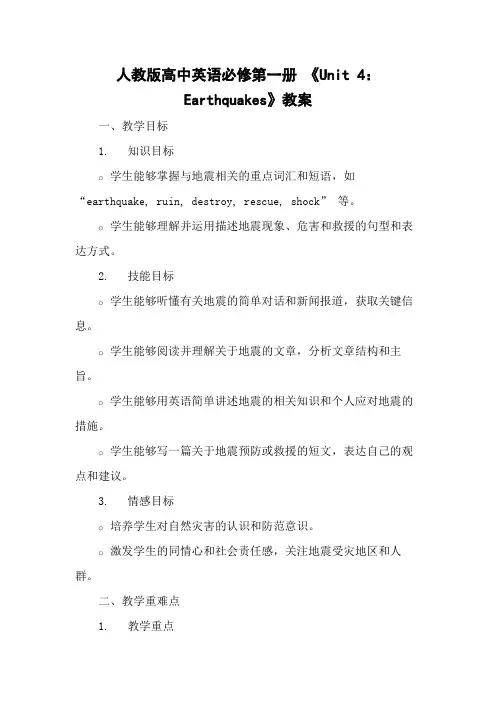
人教版高中英语必修第一册 《Unit 4:Earthquakes》教案一、教学目标1.知识目标o学生能够掌握与地震相关的重点词汇和短语,如 “earthquake, ruin, destroy, rescue, shock” 等。
o学生能够理解并运用描述地震现象、危害和救援的句型和表达方式。
2.技能目标o学生能够听懂有关地震的简单对话和新闻报道,获取关键信息。
o学生能够阅读并理解关于地震的文章,分析文章结构和主旨。
o学生能够用英语简单讲述地震的相关知识和个人应对地震的措施。
o学生能够写一篇关于地震预防或救援的短文,表达自己的观点和建议。
3.情感目标o培养学生对自然灾害的认识和防范意识。
o激发学生的同情心和社会责任感,关注地震受灾地区和人群。
二、教学重难点1.教学重点o重点词汇和短语的记忆与运用。
o对课文中地震相关内容的理解和语言表达的学习。
o培养学生用英语描述地震和表达应对措施的能力。
2.教学难点o如何帮助学生理解地震的复杂科学原理和巨大危害,并能用英语进行准确描述。
o引导学生在写作中清晰、有条理地阐述地震预防或救援的观点和建议。
三、教学方法1.直观演示法:通过图片、视频等展示地震的场景和数据。
2.问题引导法:以问题为导向,引导学生思考和探究。
3.讨论交流法:组织学生讨论地震相关话题,促进学生之间的思想交流。
四、教学过程(一)导入(5 分钟)1.播放一段地震的视频片段,展示地震的破坏力。
2.提问学生:What do you see in the video? How do you feel about earthquakes?(二)词汇学习(10 分钟)1.呈现本单元的重点词汇和短语,结合地震的情景进行讲解。
2.通过词汇练习,如填空、选择等,巩固学生对词汇的理解和掌握。
(三)阅读前准备(5 分钟)1.让学生观察课文标题和图片,预测文章的主要内容。
2.提出一些引导性问题,如:What might the article talk about earthquakes?(四)课文阅读(15 分钟)1.学生快速阅读课文,概括文章的主旨。
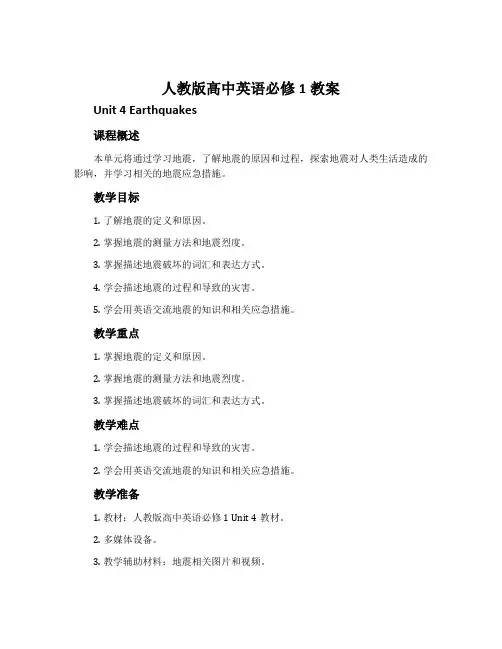
人教版高中英语必修1教案Unit 4 Earthquakes课程概述本单元将通过学习地震,了解地震的原因和过程,探索地震对人类生活造成的影响,并学习相关的地震应急措施。
教学目标1.了解地震的定义和原因。
2.掌握地震的测量方法和地震烈度。
3.掌握描述地震破坏的词汇和表达方式。
4.学会描述地震的过程和导致的灾害。
5.学会用英语交流地震的知识和相关应急措施。
教学重点1.掌握地震的定义和原因。
2.掌握地震的测量方法和地震烈度。
3.掌握描述地震破坏的词汇和表达方式。
教学难点1.学会描述地震的过程和导致的灾害。
2.学会用英语交流地震的知识和相关应急措施。
教学准备1.教材:人教版高中英语必修1 Unit 4教材。
2.多媒体设备。
3.教学辅助材料:地震相关图片和视频。
教学过程Step 1:导入引入地震话题,通过展示一些地震相关的图片和视频,激发学生对地震的兴趣。
Step 2:预习导入让学生回顾并回答上一课程的问题,复习地震的原因和地震烈度的概念。
Step 3:新课讲解1.引入新课程,并解释地震的定义和原因。
2.分析地震测量方法和地震烈度的概念。
3.教授描述地震破坏的词汇和表达方式。
Step 4:课堂练习1.教师提供一些描述地震破坏的情景,让学生用英语描述。
2.分组讨论地震破坏的方式和后果,并用英语呈现自己的讨论结果。
Step 5:拓展阅读教师提供一篇有关地震的拓展阅读材料,让学生阅读并回答相关问题,扩展学生对地震的了解和地震相关词汇的应用。
Step 6:小组活动学生分组进行小组讨论和设计,就地震应急措施展开讨论,并用英语准备一份小组演讲。
Step 7:总结与评价教师进行本节课的知识总结,并对学生的表现进行评价和鼓励。
课后作业1.整理地震相关知识,写一篇300字的地震科普文章。
2.阅读教材中的相关练习,完成练习题。
总结通过本课程的学习,学生将掌握地震的基本知识和相关词汇,能够描述地震的过程和导致的灾害,并能用英语交流地震的知识和应急措施。
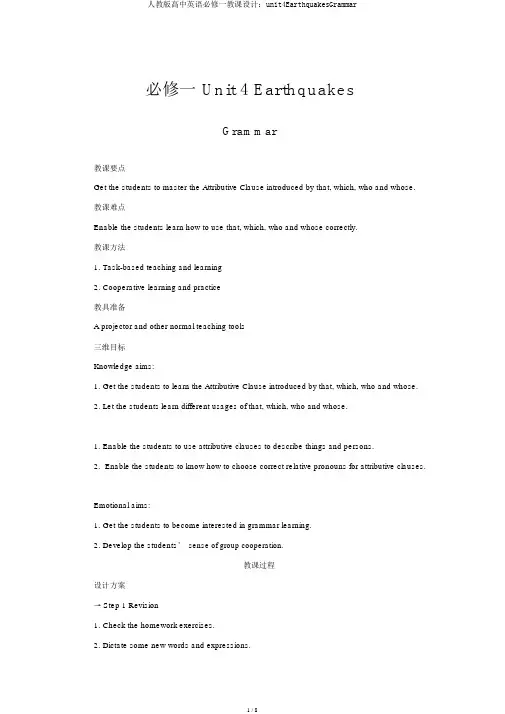
必修一 Unit 4 EarthquakesGrammar教课要点Get the students to master the Attributive Clause introduced by that, which, who and whose.教课难点Enable the students learn how to use that, which, who and whose correctly.教课方法1.Task-based teaching and learning2.Cooperative learning and practice教具准备A projector and other normal teaching tools三维目标Knowledge aims:1.Get the students to learn the Attributive Clause introduced by that, which, who and whose.2.Let the students learn different usages of that, which, who and whose.1.Enable the students to use attributive clauses to describe things and persons.2.Enable the students to know how to choose correct relative pronouns for attributive clauses.Emotional aims:1.Get the students to become interested in grammar learning.2.Develop the students’ sense of group cooperation.教课过程设计方案→Step 1 Revision1.Check the homework exercises.2.Dictate some new words and expressions.3. Translate the sentences:1)并不是全部的竹子都能长高。
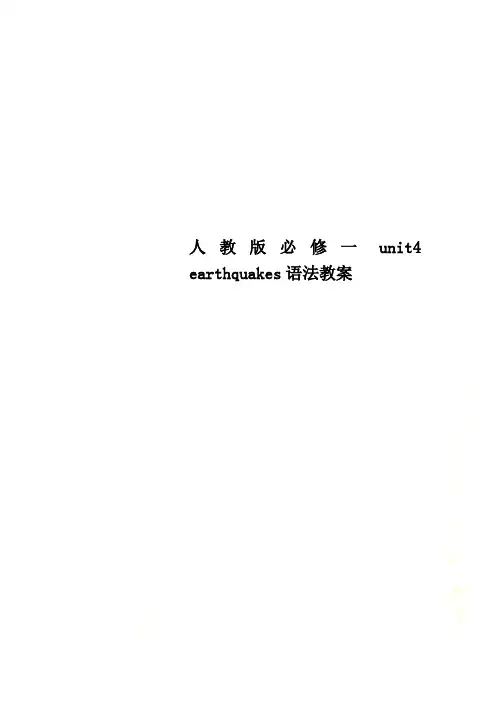
人教版必修一unit4 earthquakes语法教案人教版必修一unit4 earthquakes-语法适用学科英语适用年级高一适用区域使用人教版的地区课时2课时知识点 1.定语从句关系代词与关系副词的区别;2.限定性和非限定性定语从句;3.只能用which引导的定语从句;4.只能用that引导的定语从句;5.定语从句中关系代词作主语时谓语的形式;教学目标 1. 掌握定语从句的定义,三要素,以及关系代词的区别;2. 通过练习掌握定语从句的解题方法。
教学重点 1.that和which区别;2.whose用法;3.定语从句中谓语动词的单复数教学难点如何去区分关系代词以及定语从句的解题方法教学过程一、课堂导入Imagine your home begins to shake and you must leave it right away. You have time to take only one thing. What will you take? Why?二、复习预习教师引导学生复习上节课所学的重点单词,短语和句子词语辨析1. congratulate / celebrate2. destroy / ruin / damage / harm3. rise / raise / lift4. hurt / injure / wound词形变化1. frighten vt. 吓唬;使惊吓frightened n. 受惊的;受恐吓的frightening adj.令人恐惧的形容词修饰一个可数名词时,才可以在形容词与名词间加不定冠词“a/an”。
当句子主语能发出该不定式的动作时,可以用to + v.的主动式,当主语是该不定式动作的承受者时,则用to be + v.-ed的被动式。
温馨提示并不是所有“too ...to”结构的句子都表示否定意义,在下列情况下,“too ...to”结构可以表示肯定意义:“too ...to”结构之前带有but, only, all, never, not时,是强调肯定的表示法,意为“非常……,十分……,实在……,真是太……”等。
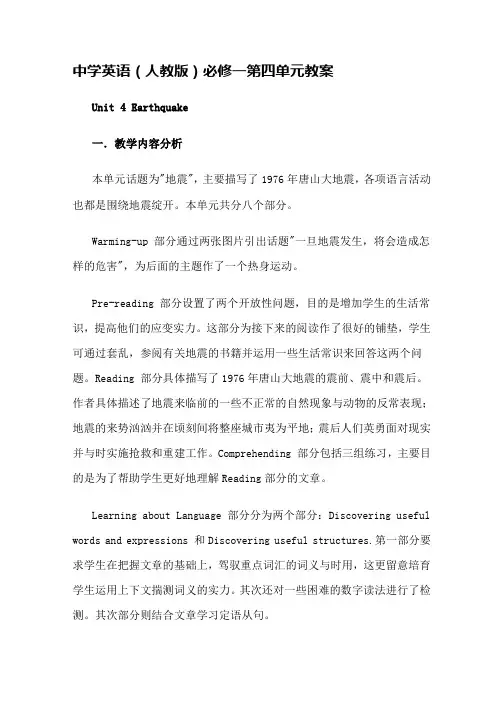
中学英语(人教版)必修一第四单元教案Unit 4 Earthquake一.教学内容分析本单元话题为"地震",主要描写了1976年唐山大地震,各项语言活动也都是围绕地震绽开。
本单元共分八个部分。
Warming-up 部分通过两张图片引出话题"一旦地震发生,将会造成怎样的危害",为后面的主题作了一个热身运动。
Pre-reading 部分设置了两个开放性问题,目的是增加学生的生活常识,提高他们的应变实力。
这部分为接下来的阅读作了很好的铺垫,学生可通过套乱,参阅有关地震的书籍并运用一些生活常识来回答这两个问题。
Reading 部分具体描写了1976年唐山大地震的震前、震中和震后。
作者具体描述了地震来临前的一些不正常的自然现象与动物的反常表现;地震的来势汹汹并在顷刻间将整座城市夷为平地;震后人们英勇面对现实并与时实施抢救和重建工作。
Comprehending 部分包括三组练习,主要目的是为了帮助学生更好地理解Reading部分的文章。
Learning about Language 部分分为两个部分:Discovering useful words and expressions 和Discovering useful structures.第一部分要求学生在把握文章的基础上,驾驭重点词汇的词义与时用,这更留意培育学生运用上下文揣测词义的实力。
其次还对一些困难的数字读法进行了检测。
其次部分则结合文章学习定语从句。
Using Language 部分分为Reading,Writing and Speaking;Listening 和Writing。
Reading,Speaking 包括读一篇邀请函,写一份演讲稿和关于一套新唐山邮票的Little talk。
Listening 部分讲解并描述了一位地震生还者的故事,并依据听力材料进行正误推断和回答问题,旨在培育学生获得细微环节的实力,并通过听来仿照标准的语音和语调。
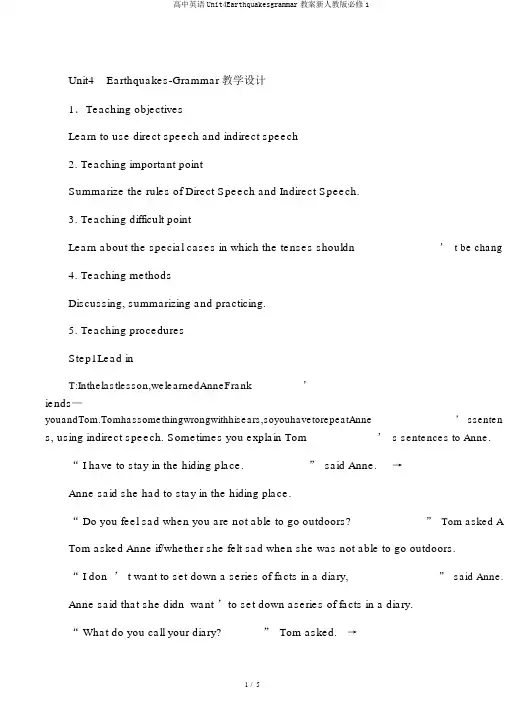
Unit4 Earthquakes-Grammar教学设计1.Teaching objectivesLearn to use direct speech and indirect speech2. Teaching important pointSummarize the rules of Direct Speech and Indirect Speech.3. Teaching difficult pointLearn about the special cases in which the tenses shouldn’ t be chang4. Teaching methodsDiscussing, summarizing and practicing.5. Teaching proceduresStep1Lead inT:Inthelastlesson,welearnedAnneFrank’iends—youandTom.Tomhassomethingwrongwithhisears,soyouhavetorepeatAnne’ ssenten s, using indirect speech. Sometimes you explain Tom’ s sentences to Anne.“ I have to stay in the hiding place.” said Anne.→Anne said she had to stay in the hiding place.“ Do you feel sad when you are not able to go outdoors?” Tom asked ATom asked Anne if/whether she felt sad when she was not able to go outdoors.“ I don ’ t want to set down a series of facts in a diary,” said Anne.Anne said that she didn want ’to set down aseries of facts in a diary.“ What do you call your diary?” Tom asked.→Tom asked what she called her diary.Ss go on this topic by themselves.Step2GrammarT:Now let ’ s look at these sentences again. If we want to change Direct Speech into Indirect Speech,what should be changed?Ss discuss by themselves.Ss: sentence structures, tenses, pronouns, adverbials of time and place and verbs should be changed.T: Quite right. Look at the form on the screen. These are the rules.直接引语变为间接引语时,要注意以下几点:人称变化、时态变化、宾语从句要用陈说句语序。
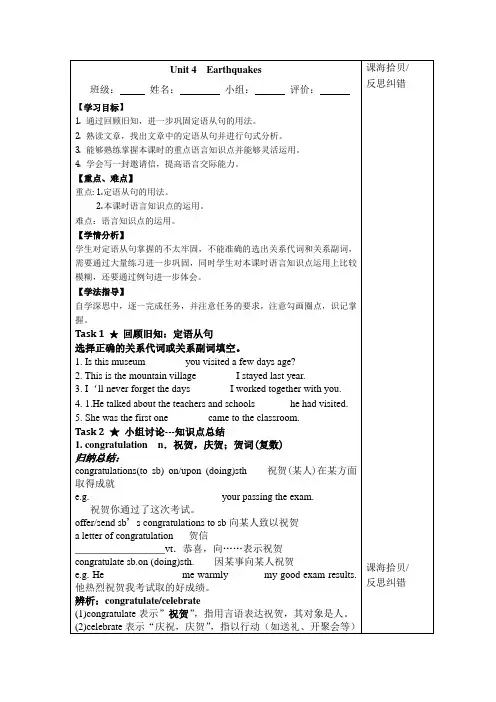
精美句子1、善思则能“从无字句处读书”。
读沙漠,读出了它坦荡豪放的胸怀;读太阳,读出了它普照万物的无私;读春雨,读出了它润物无声的柔情。
读大海,读出了它气势磅礴的豪情。
读石灰,读出了它粉身碎骨不变色的清白。
2、幸福幸福是“临行密密缝,意恐迟迟归”的牵挂;幸福是“春种一粒粟,秋收千颗子”的收获. 幸福是“采菊东篱下,悠然见南山”的闲适;幸福是“奇闻共欣赏,疑义相与析”的愉悦。
幸福是“随风潜入夜,润物细无声”的奉献;幸福是“夜来风雨声,花落知多少”的恬淡。
幸福是“零落成泥碾作尘,只有香如故”的圣洁。
幸福是“壮志饥餐胡虏肉,笑谈渴饮匈奴血”的豪壮。
幸福是“先天下之忧而忧,后天下之乐而乐”的胸怀。
幸福是“人生自古谁无死,留取丹心照汗青”的气节。
3、大自然的语言丰富多彩:从秋叶的飘零中,我们读出了季节的变换;从归雁的行列中,我读出了集体的力量;从冰雪的消融中,我们读出了春天的脚步;从穿石的滴水中,我们读出了坚持的可贵;从蜂蜜的浓香中,我们读出了勤劳的甜美。
4、成功与失败种子,如果害怕埋没,那它永远不能发芽。
鲜花,如果害怕凋谢,那它永远不能开放。
矿石,如果害怕焚烧(熔炉),那它永远不能成钢(炼成金子)。
蜡烛,如果害怕熄灭(燃烧),那它永远不能发光。
航船,如果害怕风浪,那它永远不能到达彼岸。
5、墙角的花,当你孤芳自赏时,天地便小了。
井底的蛙,当你自我欢唱时,视野便窄了。
笼中的鸟,当你安于供养时,自由便没了。
山中的石!当你背靠群峰时,意志就坚了。
水中的萍!当你随波逐流后,根基就没了。
空中的鸟!当你展翅蓝天中,宇宙就大了。
空中的雁!当你离开队伍时,危险就大了。
地下的煤!你燃烧自己后,贡献就大了6、朋友是什么?朋友是快乐日子里的一把吉它,尽情地为你弹奏生活的愉悦;朋友是忧伤日子里的一股春风,轻轻地为你拂去心中的愁云。
朋友是成功道路上的一位良师,热情的将你引向阳光的地带;朋友是失败苦闷中的一盏明灯,默默地为你驱赶心灵的阴霾。

人教版高中英语必修1《Unit4Earthquakes》教案人教版高中英语必修1《Unit 4 Earthquakes》教案【一】教学准备教学目标1. Ss will be able to master the following useful new words and expressions.well,smelly,pond,burst,canal,steam,dirt,injure,brick,dam,usel ess,steel,shock,rescue,quake,electricity,army,shelter,fresh, organize, bury, at an end, dig out, coal mine, in ruins2. Ss will be able to know the basic knowledge about Earthquake教学重难点1. The usages of some words and expressions.2. How to train the students’ reading ability in learning the text.教学工具课件教学过程Step I lead-inLet students see a short video and answer the questions1.What happened in the video? Earthquakes2.How do you feel seeing the plots(情节)? Students’ discussion.Step II Fast reading1. What is the passage mainly about? In Tangshan ,earthquakes happened on July 28th 19762. Skim the text and answer the questionsThe type of writing (写作体裁)Narrative writingTopic sentence of Paragraph 1Sentence 1Topic sentence of Paragraph 2Sentence 2Topic sentence of Paragraph 3Sentence 1Topic sentence of Paragraph 4Sentence 1Step III Detailed readingAsk students to read the text carefully and answer the questionsTask1: What were the nature signs of the coming earthquake?(选择)Para 11.Water in well( G )2. Well walls(D )3.Chickens &pigs(F )4 .Mice (A) 5.Fish(E ) 6. Bright lights( B) 7. Water pipes(C )A. Ran out of fieldsB. in the skyC. Cracked and burstD. Deep cracksE. Jumped out of pondsF. Too nervous to eatG. Rose and fell, fell and roseTask 2 Fill in the blanksMain IdeaDetailsDamage caused byearthquakePara 2-3At _____ am, the __________ earthquake of the 20th century began ._______ burst from holes in the ground.Hard hills of the rock became rivers of ____.________ covered the ground like red autumn leaves.Two _______ and most of the bridges fell.The railway tracks were now _________pieces of _______.______ now filled the wells instead of water.Water,food,and ______________ were hard to get.The reconstruction(重建) after the earthquakePara 41. The army _____________2. Workers ____________for survivors.3._____________was taken to the city.Details:1. At 3:42 am, the greatest earthquake of the 20th century began.2. Steam burst from holes in the ground.3. Hard hills of the rock became rivers of dirt.4. Bricks covered the ground like red autumn leaves.5. Two dams and most of the bridges fell.6. The railway tracks were now useless pieces of steel.7. Sand now filled the wells instead of water.8. Water, food, and electricity were hard to get.Step IV consolidation (当堂巩固)Let students fill the blanks according to the passageStrange things were happening in the countryside of northeast Hebei. For three days the water in the village wells kept rising and 1_________(fall). Farmers noticed that the well walls had deep cracks 2___________ them. A smelly gas came out of the cracks. In 3_________farmyards, the chickens and even the pigs were too nervous 4__________(eat). 5_________(mouse) ran out of the fields looking for places 6________(hide). Fish jumped out Of their bowls and ponds. At about 3 am on July 28,1976, some people saw bright lights 7_________ the sky. The sound of planes could 8________(hear) outside the city of Tangshan even9_________ no planes were in the sky.In the city, the water pipes in some buildings cracked and burst. But the one million people of the city, ________thought little of these events, were asleep as usual that night.1 falling2 in3 the4 to eat5 mice6 to hide 7in 8 be heard 9when 10 who这部分目的是让学生进一步巩固课文的内容。
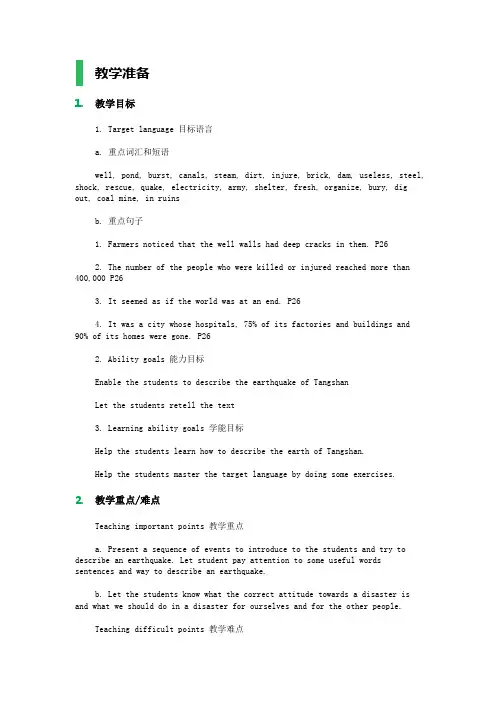
教学准备1. 教学目标1. Target language 目标语言a. 重点词汇和短语well, pond, burst, canals, steam, dirt, injure, brick, dam, useless, steel, shock, rescue, quake, electricity, army, shelter, fresh, organize, bury, dig out, coal mine, in ruinsb. 重点句子1. Farmers noticed that the well walls had deep cracks in them. P262. The number of the people who were killed or injured reached more than 400,000 P263. It seemed as if the world was at an end. P264. It was a city whose hospitals, 75% of its factories and buildings and 90% of its homes were gone. P262. Ability goals 能力目标Enable the students to describe the earthquake of TangshanLet the students retell the text3. Learning ability goals 学能目标Help the students learn how to describe the earth of Tangshan.Help the students master the target language by doing some exercises.2. 教学重点/难点Teaching important points 教学重点a. Present a sequence of events to introduce to the students and try to describe an earthquake. Let student pay attention to some useful words sentences and way to describe an earthquake.b. Let the students know what the correct attitude towards a disaster is and what we should do in a disaster for ourselves and for the other people.Teaching difficult points 教学难点Teach the students how to appreciate an article.3. 教学用具课件4. 标签Unit 4 Earthquakes教学过程StepⅠLead-in (4 minutes)Greeting each otherT: As we all know, in our daily life, many strange things may happen, doyou think so? Can you tell me what strange things may happen?StepⅡWarming-up (6 minutes)Let the students look at some pictures and think about this question: Howmany natural disasters do you know? And then introduce Sichuan and Tangshanearthquakes to the students.StepⅢPre-reading (3 minutes)There is one question in this part. It is very interesting. It can enlargetheir imagination. No matter what their answers are, as long as they have givencareful thoughts to the situations, their answers should be good.T: Imagine there is an earthquake now, and your home is shaking, at thismoment you have no time to take any other things but one, what will it be?OK. Let’s read our text, and see what it tells us.Step ⅣReading (20 minutes)Fasting Reading (5 minutes)T: At first I’d like you to read the text quickly and silently to get thegeneral idea of the article. While reading, you should pay attention to thefirst sentence of each paragraph.Two or three minutes laterT: Have you found the general idea of the text? T: What is it? And thenask the students to match the main idea of each part.Careful reading (15 minutes)T: Now, it’s time for us to read the text carefully. But before readingyou should readsome sentences first. These sentences may help you get some informationquickly and easily. Now look at the screen, and read the sentences. (Show onthe screen.)Ask them to find out the numbers of each sentence.T: the numbers can tell us the destruction of earthquakes and also canmake us gain more information of Tangshan earthquake.Step ⅤPost reading(8 minutes)Retell the passage (show a short summary of the text on the screen). Askthe students to use some words or phrases to finish the short summary.Step ⅥDiscussion (5 minutes)Ask the students to discuss this question thisquestion: What should we do to protect ourselves if an earthquake happened?。
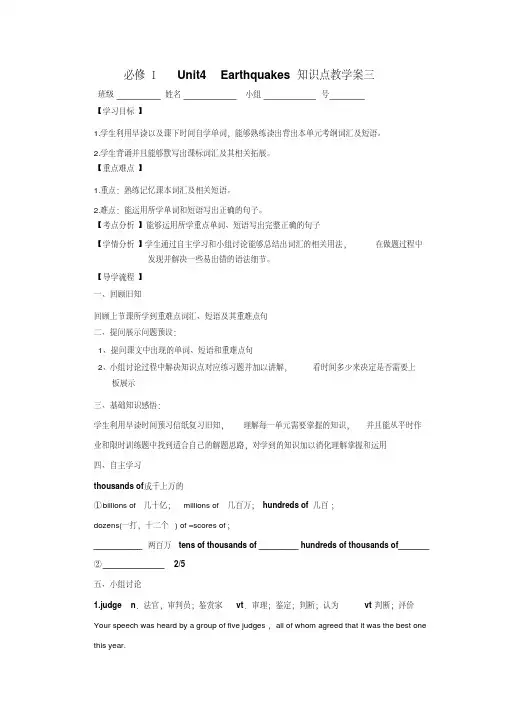
必修ⅠUnit4 Earthquakes知识点教学案三班级姓名小组号【学习目标】1.学生利用早读以及课下时间自学单词,能够熟练读出背出本单元考纲词汇及短语。
2.学生背诵并且能够默写出课标词汇及其相关拓展。
【重点难点】1.重点:熟练记忆课本词汇及相关短语。
2.难点:能运用所学单词和短语写出正确的句子。
【考点分析】能够运用所学重点单词、短语写出完整正确的句子【学情分析】学生通过自主学习和小组讨论能够总结出词汇的相关用法,在做题过程中发现并解决一些易出错的语法细节。
【导学流程】一、回顾旧知回顾上节课所学到重难点词汇、短语及其重难点句二、提问展示问题预设:1、提问课文中出现的单词、短语和重难点句2、小组讨论过程中解决知识点对应练习题并加以讲解,看时间多少来决定是否需要上板展示三、基础知识感悟:学生利用早读时间预习信纸复习旧知,理解每一单元需要掌握的知识,并且能从平时作业和限时训练题中找到适合自己的解题思路,对学到的知识加以消化理解掌握和运用四、自主学习thousands of成千上万的①billions of 几十亿;millions of 几百万;hundreds of 几百;dozens(一打,十二个) of =scores of;___________ 两百万tens of thousands of _________ hundreds of thousands of_______ ②______________ 2/5五、小组讨论1.judge n.法官,审判员;鉴赏家vt.审理;鉴定;判断;认为vt判断;评价Your speech was heard by a group of five judges,all of whom agreed that it was the best one this year.Judging by/from从...上看;根据...判断,置于句首作状语,v-ing形式不受主语的限制,构成独立成分。
人教版高中英语必修1教案Unit 4 EarthquakesUnit 4 教学设计(1) 题:Earthquaes (2) 教材分析与学生分析:本单元的主题是“地震”。
aring Up部分Pre-Reading部分要求学生描述、讨论与地震有关的话题。
Reading部分是一篇新闻报道,介绍了唐大地震前的预兆、地震造成的城市建筑和人畜损失以及地震后的救援情况。
Learning abut Language 部分涉及了本单元的词汇和语法。
该部分主要通过阅读和句型练习帮助学生学习单词、数字的表达法以及有that, hih, h, hse引导的定语从句,培养学生的自主学习能力。
Using Language部分的“读写说(Reading, riting and speaing)”训练提供了一封信,要求学生阅读后写一篇大地震纪念公园落成仪式上的演讲稿,接着说一说唐大地震纪念邮票。
随后的听力(Listening)是一位美国人以第一人称叙述他在1906年旧金大地震中的可怕经历。
写作(riting)部分训练学生如何写新闻报道,学会拟地定写作提纲。
(3) 时安排:The first perid: Reading The send perid: ReadingThe third perid: Listening The frth Perid:Graar The fifth perid: Extensive reading The sixth perid: Suar (4)教学目标:①知识与技能:了解地震的成因、预兆,地震造成的损失,地震时的应急措施以及震后的救援;掌握和运用本单元出现的新词汇和短语以及数字的表达法;熟练运用that, hih, h, hse引导的定语从句;学会写英新闻报道,拟订写作提纲。
②过程与方法:在学习阅读部分时,可以根据教学的需要和教学班级的实际,从不同的角度设计目的明确的任务。
阅读材料提及了很多孩子失去双亲成为孤儿,矿工在地震中的遭遇。
人教版高一必修1 Unit4 Earthquakes 教案Unit4 EarthquakesThe First Period Leading in, Warming up& Pre-readingBy Liu Xiaohua from Hongling Middle School一、教学目标(Teaching aims)Student’s Book1. 能力目标(ability aim)a . Let the students know something about the earthquakes.b . Enable the students to talk about what they should do ina disaster for themselves2. 语言目标(language aim)a. Words and expressionsimagine, shake, right awayb. Important sentenceWhat do you think may happen before an earthquake?二、教学重难点(Teaching important points)Let the students know what a correct attitude towards a disaster is and what they should do in a disaster for themselves and for the other people.三、教学方法 (Teaching method)a. Discussingb. Talkingc. Activities.四、教具准备 (Teaching Aids)Multi-media computer五、教学步骤 (Teaching procedure)StepⅠ. Lead-in:T: What’s the biggest sound you have heard in your life?( the sound of the wind that blew in a winter night; the nose when planes take off; the sound of trains; the sound of thunder…..) But did you once hear the sound that the heaven falls and the earth crack. In Chinese it is 天崩地裂?If there is a sound like this what is it? What will happen?Today we’ll learn somethi ng about earthquakes. Can you imagine how terrible it is?First let the students answer the following question.Which of the following may cause people the greatest damage?Earthquake, Typhoon, Flood, DroughtVarious answers are possible. Students should give reasons to support their answers. All of them are natural disasters, they have something in common, at the same time, they have many differences.Let the students know something about the earthquake. (slides)T: How does the earthquake occur?Then show the film to the students. ( film about the earthquake )T: When some plates of the earth move suddenly, an earthquake happens. Many earthquakes begin under the sea. In fact, earthquakes may happen near high mountains.During an earthquake, the shaking make rocks rise suddenly and even cracks open. Houses fall, people are killed or hurt, and sometimes the whole villages or cities are destroyed. Some villages even disappear completely.Step Ⅱ. TalkingT: Earthquakes are disasters to everybody. Now look at the two pictures of Tang Shan and San Francisco. Can you describewhat you see in the pictures?(Show two pictures to the students and tell the students they are today’s Tangshan and San Francisco. But many years ago some big earthquakes hit these two beautiful cities.)1. Show the pictures of San Francisco to the students and let them describe today’s San Francisco and then let them know what happened in San Francisco in 1906(From the picture of San Francisco, we can see it is a very big city. There are many tall buildings thickly standing on the earth. And the population of the city is very large.)2. Show the pictures of Tangshan to the students and let them describe today’ Tangshan and then let them know what happened in Tangshan in 1976.( Today’ Tangshan is a beautiful city. It has beautiful gardens, broad roads and some tall buildings.)T: But, what will happen if there has been a big earthquake in these two cities? Work in groups and discuss it. Then I’ll ask some of you to say out your opinion.( After the terrible quake, everything is destroyed, what we can see is fallen buildings and dead bodies. The policemen, the soldiers and some other volunteers are rescuing the people trapped in the ruins….)T: Right, now let’s see a film.(Let the students see a film about Tangshan Earthquake.) (film)T: After the earthquake the city of Tangshan became…..Let the students discuss what they saw. And then talk about the pictures in their own words.The house….The fire….The bridge….The road…The police an d the volunteers….The people…..( Tangshan Earthquake happened on July 28, 1976.It was the greatest earthquake of the 20th century in China. Before the earthquake, many strange things happened, but people thought little of them. Such a great number of people died during the earthquake, because the quake happened while they were sleeping. The number of people who were killed or injured reached more than 400,000. And all the traffic was almost destroyed after the quake. Thousands of thousands of people became homeless in a short time. Many soldiers were sent to Tangshan to rescue the survivors after the earthquake.Let the students talk about the damage caused by earthquakesUsing the following words and phrases:shake, break, fall down onto, hurt, destroy, h omeless, die…..Step Ⅲ. Pre-readingT: But we can avoid or at least reduce the loss caused by earthquakes. And we can foretell it.Do you know what would happen before an earthquake?Can we do something to keep ourselves safe from earthquakes?( 1. There is often a great sound.2. Animals may be too nervous to eat.3. Maybe there are bright lights in the sky.4. a smelly gas may come out of the well.5. In the city the water pipes in some buildings crack and burst.6. Scientists have studied earthquakes and make maps that show the “ earthquake belts”. In areas in these belts, it is possible for earthquakes to happen. In these areas we can build strong houses to fight against earthquakes.)Discussion & Activities1. Show some pictures to the students andlet them discuss.Let the students look at them and decidewhat situation may happen before anearthquake.2. Then fill in the missing wordsaccording to the pictures.a. The water in the wells ____ and____. And some deep ______could be seen in the well walls. A ______gas came out the cracks.b. Mice ran out the Fields ___________places to hide. Fish _________out of bows and ponds.c. The chickens and even pigs were ______ nervous _____eat. The dog was ________ loudly again and again.d. People could see _______lights in the sky.3. Let the students discuss if they have ever experienced an earthquake.Step Ⅳ Discussion & ActivitiesT: What do you think may happen before an earthquake?(Before an earthquake, animals will become nervous. Cow, pigs,, horses and dogs will be upset. And people can see mice running about. If the earthquake happens during winter, people can even see snakes.)T: Have you ever experienced an earthquake?Let the students discuss and then talk about it.Step Ⅴ HomeworkPreview Reading material and then do exercise on page 27. 1-3 ( in comprehending )。
Unit 4 Earthquake(Grammar)班级姓名小组________第____号【学习目标】1.学生通过自主学习了解定语从句基本概念2.通过小组讨论以及教师讲解分析关系代词如何使用。
【学习重点】掌握关系代词如何使用【学情分析】学生对关系代词不同情况下如何使用掌握不准【导学流程】自主学习内容一回顾旧知提问所学单词二基础知识感知:一定语从句的基本概念护士是照顾病人的人。
A nurse is a person who looks after patients.↓↓↓先行词关系代词定语从句分析下面的定语从句①Do you know the girl who is singing on the stage?____________ 为先行词;_______ 为关系代词,且在从句中作主语。
②This is the museum which was built many years ago.______________ 为先行词,_________ 为关系代词,且在从句中作______ 。
三、探究问题掌握关系代词如何使用四、基础知识拓展与迁移:将所学到的语法应用于限时训练中请及时记录自主学习过程中的疑难:小组讨论问题预设:二关系代词的使用1、由关系代词引导的定语从句以及充当的成分关系代词指代先行词,在定语从句中充当主语、宾语、定语等,因此定语从句中不能再出现关系代词所指代的名词或代词。
①Do you know the man _____/_____ was injured in theaccident?(关系代词作主语)②The boy_____/ _____ we just saw in the library is the monitor of Class Three(关系代词作宾语,可省略)③Excuse me, are you the gentleman whose umbrella/the umbrella of whom I borrowed yesterday?(关系代词作定语)④Mary is driving a car which/ that can travel 160 kilometres an hour. (关系代词作主语)⑤He has not found the mobile phone____/_____he lost last week.(关系代词作宾语,可省略2关系代词只用that而不用which的情况①当先行词为all,everything,nothing,anything,little,much等不定代词或先行词被这些词修饰时,关系代词通常用thatAll _____ can be done has been done.②当先行词是序数词、形容词最高级或先行词被序数词或形容词最高级修饰时,关系代词通常用thatThis is the most beautiful park______ I have visited.③当先行词被the only, the very,the last修饰时。
必修一Unit 4 EarthquakesGrammarI. Teaching aims:1. Enable students to know the attributive clause and the usage of relative pronouns.2. Enhance stude nts’ p roficiency and accuracy in using the attributive clause.3. Stimulate students’ interest in learni ng English grammar and enable students to express their thankfulness.II. Teaching important and difficult points:Enable students to master the usage of relative pronouns and use the attributive clause properly. III. Teaching methods:Communicative teaching method; Task-based teaching method.IV. Teaching Aids:Multimedia, paper, a blackboard and chalk,.V. Teaching proceduresStep I:Lead inT: What day is it today?S: Thursday.T: It is the fourth Thursday in November. So it is Thanksgiving Day today.Enjoy and sing a song together. (The lyrics of the song include attributive clauses)Purpose: To draw students’ attention by singing the beautiful song.Step II:Explain the usage of relative pronouns and ask students to make sentences.1.By combining sentences to discover the usage of relative pronouns2.By making sentences using people and things around us to enhance students’ proficiencyand accuracy in using the attributive clause.Purpose: Enable the students to acquire theusage of relative pronouns and cultivate their confidence.Step III:Exercises (Competition between boys and girls)Six kinds of exercises:Correct; Speak and guess; Listen and count; Translate; Choose; Make sentencesPurpose: Through various exercises to enable students to have a command of what they have learned.Step IV:Make a card (Group work)Make a card for the person who you are grateful to on this special day.Purpose: Cultivate st udents’ cooperative ability and learn to write using the attributive clause.Step V:Fill in the blanks and conclude the cases where only “that” can be used.Then raise a question Do you know the cases where only “which” can be used.Purpose: Enable stu dents to understand “Knowledge is endless” and the necessity of keep on learning.StepⅥ: SummaryAsk students to look at the blackboard and sum up what they have learned.StepⅦ: HomeworkWrite a letter to the person who you are grateful to.Purpose: Writing is one of the most important skills. Through writing, students can have a good command of relative pronouns and the attributive clause.Blackboard designThe Attributive ClauseRelative pronouns: who, whom, which, that, whose(Ask students to fill in the blanks)that: 1. everything 2. the best 3. the first 4. the only5. people & things6. who & which。
必修ⅠUnit 4 Earthquakes 语法教学案班级姓名小组号【学习目标】1.理解并掌握定语从句的概念2.理解并掌握关系代词和关系副词及其用法【重点难点】1.重点:熟读课本重难点句。
2.难点:能运用所学完成定语从句练习题。
【考点分析】能够运用所学书写正确的句子【学情分析】学生通过自主学习和小组讨论能够总结本单元语法的定语从句相关用法。
【导学流程】一、回顾旧知回顾课文中涉及到的定语从句二、提问展示问题预设:1、定语从句中关系代词that,which,who,whom,whose翻译为什么意思2、定语从句中关系代词that,which,who,whom能否省略?哪种情况下可以省略?3、定语从句中关系代词和关系副词有何区别?三、基础知识感悟:学生利用早读时间预习新知复习旧知,理解每一单元需要掌握的知识,并且能从平时作业和限时训练题中找到适合自己的解题思路,对学到的知识加以消化理解掌握和运用四、自主学习Ⅰ.定语从句的概念在复合句中,修饰某一名词或代词的从句叫定语从句。
被修饰的名词或代词叫先行词,定语从句一般放在先行词的后面。
Ⅱ、定语从句的关系词引导定语从句的关系词有关系代词和关系副词,常见的关系代词包括that, which,who(宾格whom,所有格whose)等,关系副词包括where, when, why等。
关系代词和关系副词放在先行词及定语从句之间起连接作用,同时又作定语从句的重要成分。
Ⅲ、定语从句的分类根据定语从句与先行词的关系,定语从句可分为限制性定语从句及非限制性定语从句。
限制性定语从句紧跟先行词,主句与从句不用逗号分开,从句不可省去,非限制性定语从句主句与从句之间有逗号分开,起补充说明作用,如省去,意思仍完整。
Ⅳ、关系代词的用法1. that:既可以用于指人,也可以用于指物。
在从句中作主语或宾语,作主语时不可省略,作宾语可省略。
Mary likes music that is quiet and gentle.玛丽喜欢轻柔的音乐。
教学过程一、课堂导入Imagine your home begins to shake and you must leave it right away. You have time to take only one thing. What will you take? Why?二、复习预习教师引导学生复习上节课所学的重点单词,短语和句子词语辨析1. congratulate / celebrate2. destroy / ruin / damage / harm3. rise / raise / lift4. hurt / injure / wound词形变化1. frighten vt. 吓唬;使惊吓f rightened n. 受惊的;受恐吓的frightening adj.令人恐惧的2. nation n. 民族;国家;国民national adj. 民族的;国家的3. suffer v. 受苦; 吃苦头suffering n. 苦难;痛苦sufferer n.受苦者; 受难者重点单词1. burst v.&n. 爆裂, 爆发, 突然破裂2. ruin v.&n. 毁灭,使破产,遗迹,废墟(名词时常用复数)3. rescue n.&vt. 援救,营救4. judge n.&v. 法官,鉴赏家,裁判,判断,估计重点词组1. right away 立刻,马上2. at an end 结束,终结3. instead of 代替,而不4. tens of thousands of 数以万计的重点句子1. Mice ran out of the fields looking for places to hide.2. All hope was not lost.三、知识讲解知识点1:重点句型12. In the farmyards, the chickens and even the pigs were too nervous to eat.农家大院里的鸡,甚至猪都紧张得不吃食。
“too + adj./adv.+动词不定式”结构简称为“too ... to”结构,在大多数情况下表示否定意义,通常可意为“太……而不能……;太……无法……”。
“too ...to”结构表示否定的常见句型有:too +adj./adv. + to do,有时too后也可跟一个起形容词作用的过去分词。
too ... to/to be done形式。
这是“too ...to”结构中不定式为被动式时的变体,如果主语是不定式动作的承受者,不定式既可以用主动式,也可以用被动式,此时用主动式虽然在形式上是主动的,但在意义上却是被动的。
too + adj. + a (an) + n.+ to + v./to be done形式。
这个句型在too+ adj.后再接一个带不定冠词的名词,不定冠词一定要放置于形容词后。
与此同时,只有当too后形容词修饰一个可数名词时,才可以在形容词与名词间加不定冠词“a/an”。
当句子主语能发出该不定式的动作时,可以用to + v.的主动式,当主语是该不定式动作的承受者时,则用to be + v.-ed的被动式。
温馨提示并不是所有“too ...to”结构的句子都表示否定意义,在下列情况下,“too ...to”结构可以表示肯定意义:“too ...to”结构之前带有but, only, all, never, not时,是强调肯定的表示法,意为“非常……,十分……,实在……,真是太……”等。
“too ...to”结构中带有表示某种心情或描绘性的形容词或副词,如ready,eager, satisfied, kind, willing, easy, anxious等加动词不定式结合成一个不可分割的状态、态度、倾向或心情等,并且其后的不定式不是说明too的具体内容,而是修饰形容词,故不定式不再表示结果。
在“too ...to”结构中,不定式为否定式时,是构成的双重否定,其意为“非常/很/太/那么……不会不/必定能/所以能……”,也不表示否定意义。
I,m too tired to think of anything now.我太累了,什么也不能想了。
The tea is too hot to drink/to be drunk. 茶太热,不能喝。
The shoes are too badly broken to be mended.这些鞋子破烂得不能修补。
He,s too experienced an artist to mind what the critics say. (=As an artist he,s too experienced to mind what the critics say.)他是个经验非常丰富的艺术家,不会介意批评家说些什么。
He is too experienced an artist to be worried by what the critics say.他是一个经验非常丰富的艺术家,不至于为批评家们的议论而担忧。
I am but too glad to do so. 我非常喜欢这样做。
He was too anxious to do this job. 他非常想做这件工作。
The girl is too careful not to do it well.这姑娘很细心,完全能做好那件事。
13. It seemed as if the world was at an end!仿佛到了世界末日!联想拓展as if=as though意为“仿佛,像,似乎”。
通常用在be,look,seem,sound,taste,smell及feel等连系动词的后面。
如果表示真实情况应该用陈述语气;如果表示非真实情况则应该用虚拟语气, 其谓语动词的虚拟式与wish后面宾语从句中谓语动词的虚拟式相同。
引导方式状语从句时也要用虚拟语气。
注意:as if (though)后面除了跟句子外,还可以跟名词、动词不定式、形容词(短语)、介词短语和分词。
另外,as if (though)还可以表达感叹语气,来对某项建议、假设和推测表示不赞成、惊讶、不满和厌恶等。
How wild his white hair looked as if it had been electrified! 他的白发十分凌乱,好像触了电似的。
(虚拟语气)She seems as if she is going to cry. 她似乎要哭了。
(陈述事实)As if anyone would believe that story!好像有人竟会相信那样的事!As if we were all stupid and he alone clever!哼,就仿佛我们都是傻瓜,只有他一个人聪明似的。
He raised his hand as if to take off his hat.他举起他的手,好像要取下帽子。
He behaved as if nothing had happened.他表现的好像什么也没发生。
14. All hope was not lost.不是所有的希望都破灭了。
all, both, each, every, everyone, everything, always, whole, wholly, entirely, altogether等具有总括意义的词后跟否定词not连用时,一般都表示部分否定,其中all, both, each, every无论在not之前还是之后,都表示部分否定。
但如果句子中出现下列单词或短语则该句为全部否定:none of+n./pron.; neither+n./pron.; no+n.; nothing;nobody;neither;never;nowhere;neither ... nor等。
All that glitters is not gold. 发光的不一定都是金子。
Not all body languages mean the same thing in different countries.并非所有的肢体语言在不同的国家里都有相同的意思。
Each machine here is not produced in our plant.这里的机器不全是我们厂生产的。
知识点2:重点语法:定语从句由that, which, who, whose关系代词引导的定语从句用法简述如下。
1、that指人亦可指物,在定语从句中作主语或宾语,宾语可以省略;The girl that was crying just now is my best friend.刚才哭的那个女孩是我最好的朋友。
2、which指物,在定语从句中作主语或宾语,宾语可以省略;China is a country which has a long history. 中国是一个具有悠久历史的国家。
3、who 指人,在定语从句中作主语或宾语,宾语可以省略;The man who was here yesterday is a painter.昨天在这里的那个人是位画家。
(who作主语)The man who I saw is called Smith.我见到的那个人名叫史密斯。
(who作宾语,亦可省略)4、whose是属格,指人也可指物,在定语从句中作定语I live in a room(,) (whose windows) =(the windows of which)face south.我住在一个窗户朝南的房间里。
【点拨】辨析that, which;who ,that相同点:都可以指物不同点:如下1、在下列情况下只能用that而不能用which引导定语从句(1)当先行词是不定代词是不定代词all, little, few, much, none,, anything, nothing, everything等时。
(2)当先行词被最高级、序数词以及the very, the few, the only修饰时。
(3)当先行词被all, little, much, some, any, no, every等词修饰时(4)当先行词由表示人和物的两个并列的名词构成时。
(5)当主句是以which或who特殊疑问句时。
(6)当引导词在从句中作表语时2、在下列情况下只能用which而不能用that引导定语从句(1)介词后;(2)非限定性定语从句。
相同点:都可以指人,在句中作主语不同点:如下指人时,在下列情况下一般选用who:(1)当先行词为those, one, anyone, nobody等不定代词时。